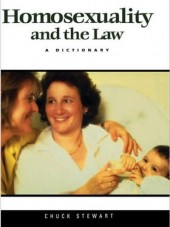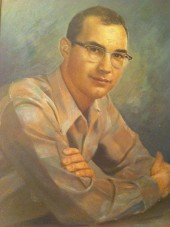 Homosexuality and the Law: A Dictionary
Homosexuality and the Law: A Dictionary
by Chuck Stewart
Published by ABC-CLIO
Published May 29, 2001
429 pages
Find on Amazon.com
Review by Billy Glover
Submitted May 04, 2004
I was surprised a day or two ago in the Broadmoor Library, in Shreveport LA, to see on a desk a copy of the book, Homosexuality and the Law: A Dictionary, by Chuck Stewart (published in 2001 by ABC-CLIO, (Contemporary Legal Issues Series).
It is a well done book, of about 430 pages, alphabetical on topics of homosexuality. Obviously I feel that his short view of the history of the movement is slanted since he apparently never mentions Don Slater or the Homosexual Information Center and seems to list a few people but does not list such founders as Dale Jennings.
Here are a few of my thoughts and to show that he does find space for a comprehensive coverage, even though he seems to duplicate certain issues and people, such as marriage seems to be covered several places, but of course now this seems to be a good thing.
He covers Harry Hay three times, Jim Kepner once, and Dorr Legg once. He mentions twice or more the ONE Inc. v. Oleson court case (over publishing material about homosexuality — ONE magazine in this case — but never mentions Eric Julber who never seems to get credit for the successful work he did.
I know my notes are not good, but it is important to point out that he mentions ISHR as doing business as ONE, Inc., which of course was not true. They were separate then, if not now.
Stewart covers history such as Ulrich in Germany, Hirschfeld, the 1934 Röhm Brown Shirt issue, and that 50,000 homosexuals died in the Holocaust. He starts the movement with Henry Gerber in 1924 and says there were 10,000 discharges for sex in World War II. He gives credit to the Kinsey books (1948 men and 1950 women) and then to Cory’s book in 1951.
He mentions ONE about five times, as an organization, as he does Mattachine, and then goes from the main work, in Southern California, to cover Mattachine in New York, mentioning Tony Segura, The League, Sam Morford, and how they were conservative, as were people in L.A., then mentions Frank Kameny and the Daughters of Bilitis (DOB), and how they picketed back East, as if we had not picketed in L.A and San Francisco and SIR had not done great work with/against the police etc. I don’t think he mentions Hal Call’s Mattachine work, or Don Lucas. He does mention Dr. Evelyn Hooker.
Stewart, of course, covers Stonewall in 1969, mentioning Michale Brown, and Dick Leitsch, only because of Dick’s not liking the Stonewall coverage. Then the founding of the GLF and GAA in 1960. He then points out that by 1973 there were over 1,000 groups working for the cause, mentioning by 1984 the Project 10 work with young people.
If later it is listed, he does not give importance to the changing of the sodomy law in Illinois, yet covers Romer v Evans and 1998 Clinton issues.
He mentions work with young homosexual students and some education issues but in a list of court cases or legal issues does not mention the Donald Odorizzi case, but does mention 1969 Morrison v Board of Education case. I had never heard, although he credits Katz with it, that Harry Hay had met Champ Simmons who had been connected with Henry Gerber, and says Harry was at USC. BUT the most important problem I find is that he always refers to ONE Magazine as One Newsletter! How could anyone make such a obvious mistake? He also says that ONE “absorbed” Mattachine.
Stewart covers the HRC in 1980 and the Task Force in 1973. He spells Dorr’s name as “Door” and confuses me on the issue of ONE, Inc., and IGLA. He apparently used Blumenfeld and Gay Almanac as his only resources for much on ONE. I got the impression that he says Jim Kepner was a Mattachine leader. He does mention Fred Snyder, the attorney.
He does cover a subject dear to Don Slater’s heart, the question of whether homosexual citizens are a “suspect class.” And it seems a good coverage. One point he makes that I especially like is that in the issue of homosexuality there is the question/problem of listening to the testimony of scientists versus the moralists. He uses Walter Williams’s book, The Spirit and the Flesh.
Stewart covers state and local laws (sex, marriage, hate crimes, etc.). He gives mention of the Tulane University Law publication and on-line resources and, for instance, a contact in states such as in Louisiana: the Civil Rights work in Baton Rouge.
I wonder how much coverage this book and others by this publisher get? I was glad to see it in the library here. I find articles or mention of several people, as this man, that were or are connected with USC. I just wonder if they all know each other.


